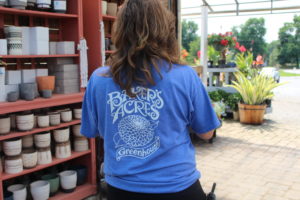Who Are You? What Do You Really Sell?
Anyone who turned on their TV from early November through Christmas Day was bombarded with commercials touting virtually every product and service known to man. (And I believe there was a plot among the network stations to sync their ad slots to eliminate the ability to flip between channels to avoid ads, forcing us to watch even the bad commercials.)
Some of the ads were terrible (did someone say Chia Pet or the Clapper ads?), some were tolerable and some were truly enjoyable and memorable to the point of actually being better than the content of the TV shows themselves!
So what set the terrible ads apart from the great ads? At the end of the day, they were all trying to either sell a specific product or entice you to visit their shopping venue, whether that venue was online or brick and mortar.
The key difference was most of the bad and mediocre commercials focused almost solely on delivering product-specific messages, mostly with a price-value qualifier, while the best ads told a story where the viewer could relate to an emotional message that was innately shared.
In the better ads, if a product was even shown (and in many cases it wasn’t), price was never the focal point and wasn’t mentioned. According to the leading marketing industry publication Advertising Age, 25 percent of the viewers polled selected the Target flight of TV commercials as their No. 1 choice for effective and memorable commercials during the Christmas selling season.
Be Relatable
If you recall Target’s ads, they told a story, featuring a combination of real children, pets and animated characters in a whimsical setting, using products as props (with no reference to price) and lyrical music in the background.
Target’s marketing team, as well as many of the other better holiday ad campaigns, focused intently on creating enduring, emotional connections with their viewing audiences.
It’s critically important to note that values expressed in the stories of these commercials were consistent with, and reinforced, the core values of the companies themselves.
If these values were not aligned, there would be a major disconnect for the consumer, and the commercials would be counterproductive.
According to research firm Corporate Executive Board, in a study of more than 10,000 consumers and dozens of different brands, there was clear evidence that, if executed correctly, there is tremendous value in taking this “emotional approach,” showing how much of a difference consumers see in your products and services and their positioning.
Across categories, consumers saw very little difference in the brands’ delivery of product and service features, but a huge range in the emotional “wrapper” around them, and that differential is significant.
In fact, according to this research, improvements in differentiating the emotional elements of a brand yield a 50 percent greater impact on consumer loyalty than do the same improvements in a brands’ functionality.
The best brands make consumers feel good about a purchase; they intently position their brands around a “shared value,” a belief held by the brand and its consumers about a higher purpose, passion or philosophy that has meaning beyond the product or category.
Create a Unique Brand Message
We often think of a “brand” as something that helps explain what the features of a product may be or what categories or services are offered within your store, and these then are what we communicate as our “brand message” in our marketing to the consumer.
But as the studies referenced above show, the average consumer has a tough time differentiating between you and the guy down the street if the brand messages are based solely on product and services; in this case the only real differentiator is price.
Maybe you should consider building your brand around what benefits you provide to the consumer, providing the consumer with an emotional reason built on shared values to get them through your front door and to build loyalty.
Consider these successful companies: Nike, Whole Foods, Lululemon (women’s yoga apparel), REI (adventure equipment and apparel), Wal-Mart, Home Depot, Lowes, Pedigree Dog Food, Mini-Cooper and Southwest Airlines.
Each one of them has a very focused core value and benefit around which they create their brand message and image, and this drives everything they do, how they do it, and what they communicate to their consumer; this is what they are really selling and what their consumer is really buying:
Nike … the potential to unleash one’s inner athlete
Whole Foods … the idea of a healthier, more holistic lifestyle
Lululemon … inner peace and spiritual health
REI … the chance to discover our inner outdoors
Wal-Mart … “Save money. Live better.”
Home Depot … “More saving. More doing.”
Lowes … “Never stop improving.”
Pedigree Dog Food … all dogs deserve to be fed well and to have a loving home.
Mini-Cooper … the “Awesomeness of small.”
Southwest Airlines … “The freedom to travel.”
Think for a second about each of these companies, their services and products; their signage, merchandising and displays; their marketing and advertising; their staffing and training levels … their brand.
Everything they do, the way they operate and communicate and the way they position themselves is supportive of the core value that is the center of their shared emotional connection with their customer.
This is how customers differentiate them from their competition and what sets them apart.
Use Product as Means
Is price a component of the companies’ brands? Sure it is, but in this equation, it falls way back in their list of decision factors.
If your brand is based on having nice green goods, hardlines, services and staff, and the competitor down the street has the same things you do, is a mile closer to the customer and is 25 cents cheaper, you lose the sale because there’s no emotional differentiation or connection.
You haven’t provided a reason for brand loyalty or you haven’t given that customer a compelling reason to come to you rather than the other guy.
I’ve said this before, but it warrants repeating; what you’re selling (plants, flowers, trees, shrubs and other outdoor stuff) at a certain price isn’t what the customer is buying!
What the consumer is looking to purchase is: inspiration, dreams, eco-systems, sustainability, entertainment, an outdoor living room, ideas, pride, relaxation, peace and solitude, family time, a sense of satisfaction, success, solutions, a better quality of life … and the list goes on.
Here’s your takeaway … you already have all of these things the consumer wants to buy; you’re just not communicating and positioning it correctly.
You need to rethink what you’re doing, how you’re doing it and how you’re communicating it … from a consumers’ perspective, not your own.
Your products and services are the means of delivering the inspiration, the ideas, the confidence and the solutions the customer is looking to purchase; your products and services are a means to the end, not the end unto themselves as we currently present them.
Your brand is just as important to your success as your products and services.
Building your brand, and brand support that conveys to the consumer your core values and connects to them on an emotional level, is the only profitable means of differentiation leading to improved brand loyalty.
So I ask again … Who are you? What do you really sell?…

















 Videos
Videos





